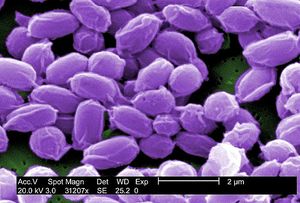Leuconostoc mesenteroides: Difference between revisions
No edit summary |
No edit summary |
||
| Line 11: | Line 11: | ||
'''NCBI:''' [http://www.ncbi.nlm.nih.gov/Taxonomy/Browser/wwwtax.cgi?mode=Info&id=203120&lvl=3&lin=f&keep=1&srchmode=1&unlock Taxonomy] | '''NCBI:''' [http://www.ncbi.nlm.nih.gov/Taxonomy/Browser/wwwtax.cgi?mode=Info&id=203120&lvl=3&lin=f&keep=1&srchmode=1&unlock Taxonomy] | ||
==Species Description | ==Species Description== | ||
The species is generally viewed as being a cocci, forming long chains or pairs during its growth. However, the morphology can change depending on what media the species is grown on, which can change them to rod shaped or more simply, elongated forms. The cells are Gram positive, which can aid in identification in human pathology. The bacteria is also a sporogenous and non-motile species. (citation HERE). They are a facultative anaerobe and are a member of the lactic acid bacteria family, which includes O. oeni, which are also closely related to the Lactobacillaceae (also a LAB), which split off from the Streptococcaceae. (CITATION HERE) | The species is generally viewed as being a cocci, forming long chains or pairs during its growth. However, the morphology can change depending on what media the species is grown on, which can change them to rod shaped or more simply, elongated forms. The cells are Gram positive, which can aid in identification in human pathology. The bacteria is also a sporogenous and non-motile species. (citation HERE). They are a facultative anaerobe and are a member of the lactic acid bacteria family, which includes O. oeni, which are also closely related to the Lactobacillaceae (also a LAB), which split off from the Streptococcaceae. (CITATION HERE) | ||
==Applications and Uses== | |||
L. mesenteroides is primarily found upon the skins of a large variety fruits and vegetables. Under the correct micro anaerobic conditions, the L. mesenteries is actually responsible for beginning the fermentative processes on many standard foods such as kim-chi, sauerkraut, and it even is included in the starter cultures of various breads and dairy cultures (Server-Busson et al. 1999). On sauerkraut specifically, the pH is lowered in the first phase by Klebsiella and Enterobacter species. This lowers the pH so that L. mesenteries can take hold and further lower the pH. The third and final stage of the fermentation is then taken up by other LABs related to L. mesteroides (namely, L. pantarum), and lowers the pH even more. (Belitz et al. 2009). With L. mesteroides, this process would be missing a niche in which the full fermentation of a commercial product could not be completed, and shows the importance that L. mesteroides has in shaping its own environment. | L. mesenteroides is primarily found upon the skins of a large variety fruits and vegetables. Under the correct micro anaerobic conditions, the L. mesenteries is actually responsible for beginning the fermentative processes on many standard foods such as kim-chi, sauerkraut, and it even is included in the starter cultures of various breads and dairy cultures (Server-Busson et al. 1999). On sauerkraut specifically, the pH is lowered in the first phase by Klebsiella and Enterobacter species. This lowers the pH so that L. mesenteries can take hold and further lower the pH. The third and final stage of the fermentation is then taken up by other LABs related to L. mesteroides (namely, L. pantarum), and lowers the pH even more. (Belitz et al. 2009). With L. mesteroides, this process would be missing a niche in which the full fermentation of a commercial product could not be completed, and shows the importance that L. mesteroides has in shaping its own environment. | ||
Revision as of 21:39, 30 April 2014
Classification
Higher Order Taxonomic Information
Bacteria; Firmicutes; Bacilli; Lactobacillales; Leuconostocaceae
Species Name
Leuconostoc mesenteroides subsp. mesenteroides ATCC 8293
NCBI: Taxonomy
Species Description
The species is generally viewed as being a cocci, forming long chains or pairs during its growth. However, the morphology can change depending on what media the species is grown on, which can change them to rod shaped or more simply, elongated forms. The cells are Gram positive, which can aid in identification in human pathology. The bacteria is also a sporogenous and non-motile species. (citation HERE). They are a facultative anaerobe and are a member of the lactic acid bacteria family, which includes O. oeni, which are also closely related to the Lactobacillaceae (also a LAB), which split off from the Streptococcaceae. (CITATION HERE)
Applications and Uses
L. mesenteroides is primarily found upon the skins of a large variety fruits and vegetables. Under the correct micro anaerobic conditions, the L. mesenteries is actually responsible for beginning the fermentative processes on many standard foods such as kim-chi, sauerkraut, and it even is included in the starter cultures of various breads and dairy cultures (Server-Busson et al. 1999). On sauerkraut specifically, the pH is lowered in the first phase by Klebsiella and Enterobacter species. This lowers the pH so that L. mesenteries can take hold and further lower the pH. The third and final stage of the fermentation is then taken up by other LABs related to L. mesteroides (namely, L. pantarum), and lowers the pH even more. (Belitz et al. 2009). With L. mesteroides, this process would be missing a niche in which the full fermentation of a commercial product could not be completed, and shows the importance that L. mesteroides has in shaping its own environment.
L. mesenteroides has a circular chromosome with 2075763 nucleotides, 2003 protein encoding genes, and 85 RNA genes.
Human Infection
L. mesenteroidies is a normal occurrence on fruits and vegetables, and is generally not considered to be an infectious agent in humans. However, there are certain documented instances where L. mesenteroidies has actually caused disease within humans. The most surprising of which was a case study where a woman, who was originally thought to have brain tumors, actually had two purulent lesions in her brain that were later successfully identified as an L. mesenteroidies infection. Another case is shown where L. mesenteroidies

